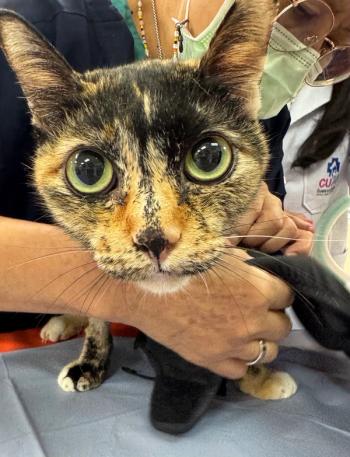
Management of heart failure (Proceedings)
The technician should appreciate the definition and causes of CHF, as well as methods of evaluation. The drugs used to treat CHF should be understood, as well as related side-effects. This awareness improves both patient care and client communications.
The technician should appreciate the definition and causes of CHF, as well as methods of evaluation. The drugs used to treat CHF should be understood, as well as related side-effects. This awareness improves both patient care and client communications.
Definition of CHF
Congestive heart failure (CHF) is a common disorder of dogs and cats and is characterized by a cardiac lesion, insufficient cardiac output, and maladaptive compensations that restore blood pressure but injure the patient. For example, the sympathetic nervous system and the renin-angiotensin-aldosterone system are triggered in CHF. However, chronic activation of these systems also damage heart muscle and blood vessels. In most cases there is elevation of venous pressures behind the failing side of the heart creating "congestion" in the organs drained by that venous circulation. Left-sided CHF typically causes pulmonary edema with respiratory signs and dysfunction. Right-sided CHF is characterized in dogs by hepatomegaly and ascites. Pleural effusion is a consequence of right-sided or left-sided CHF and is typical of many cats with chronic heart muscle diseases (cardiomyopathies).
Causes of heart failure
The most common causes of heart failure in DOGS include the following disorders. Valvular endocardiosis is the most common reason for CHF in older dogs. It is characterized by progressive atrioventricular valve degeneration and typical heart murmurs of mitral and tricuspid regurgitation. Atrial arrhythmias and left mainstem bronchial compression may complicate the picture. Systemic hypertension due to concurrent renal or Cushing's disease can worsen the situation. Dilated cardiomyopathy is a primary myocardial disorder wherein progressive contractility failure leads to CHF. Often associated with cardiac arrhythmias, such as atrial fibrillation and ventricular tachycardia, the condition is "idiopathic" but genetically predisposed in many breeds. Left- and right-sided CHF, as well as sudden cardiac death, are common outcomes. Infective endocarditis is a bacterial infection of the cardiac valves, typically affecting the mitral and aortic valves in dogs. This disorder is relatively uncommon and is very rare in cats, but may lead CHF. Congenital heart defects, including patent ductus arteriosus and pulmonic stenosis, are other causes of heart failure. Pericardial effusion is an under-recognized cause of CHF, but treatment is very different than for the conditions above, and does not involve cardiac drugs.
In comparison, the main causes of CHF in CATS are primary and secondary heart muscle disease or cardiomyopathies. These conditions impair the filling or pumping functions of the left ventricle. Common conditions are hypertrophic cardiomyopathy (HCM) and restrictive (fibrotic) cardiomyopathy (RCM). Chronic and severe hyperthyroidism and systemic hypertension also can lead to CHF in cats.
Diagnosis of heart failure
Diagnosis of CHF requires a careful clinical examination and no historical findings are specific for the condition. In most cases, exercise intolerance can be identified. Respiratory symptoms (tachypnea, dyspnea, or cough) will be observed in left-sided CHF. In right heart failure, the abdomen may be obviously distended with ascitic fluid (especially in dogs). Auscultation may indicate a heart murmur, arrhythmia, or gallop sound (an extra sound indicating abnormal cardiac filling). The lungs may auscult abnormally. Thoracic radiography is very helpful for diagnosis of left-sided CHF, but it may not be safe for the patient to obtain radiographs until initial patient stabilization. The key findings are 1) left-sided cardiomegaly; 2) pulmonary venous congestion or distension; and 3) lung infiltrates compatible with pulmonary edema. Pleural effusions are also readily evident from radiographs. Diagnosis of right-sided CHF is usually made from physical diagnosis, recognition of cardiomegaly, and echocardiography. The EKG may be helpful for identification of cardiac-enlargement patterns and arrhythmias; however, it is not a very sensitive test for heart disease and is often near-normal in animals with heart failure. Routine clinical laboratory tests, especially those of kidney function (serum urea nitrogen and creatinine) are important to obtain as many drugs may impair kidney function. Blood troponin is increasingly measured to identify heart muscle injury in selected cases. A pro-hormone called NT-BNP is released in higher quantities by the heart in heart failure and is commercially available as a "biomarker" for heart disease/failure. Arterial blood pressure (BP) should be measured in all patients with CHF. Echocardiography is the clinical gold standard for diagnosis of heart diseases in animals, and is very helpful in many cases of suspected CHF.
Initial (hospital) therapy
Initial therapy of CHF involves the following: F-O-N-S. Furosemide is a potent diuretic for mobilization of edema and is initially given by IV or IM route. A newer approach is to deliver furosemide (after initial bolus) by constant rate intravenous infusion via a syringe pump. Oxygen should be administered to dyspneic or cyanotic patients using an incubator, oxygen cage, or nasal tube. Nitroglycerine ointment (2%) dilates veins and may help to lower venous pressures (less often the potent IV sodium nitroprusside is used). Nitroglycerine should be applied using gloves; while often applied to the inside of the ear pinnae, the dosage is related to covered surface area of skin. Sedation may be needed for anxious patients. In dogs, butorphanol (0.25 mg/kg IM) is generally well tolerated and can be repeated in 30 to 60 minutes. Heavily sedated dogs should be placed in a position optimal for ventilation (sternal recumbency; head and neck straightened; support under the chin). In cats, butorphanol (0.2 mg/kg) mixed with very low doses of acepromazine (0.025 mg/kg) is usually well tolerated (except in hypothermic or hypotensive cats when ACE is avoided). Dogs or cats in cardiogenic shock (defined as a systolic blood pressure of <80 mm Hg, hypothermia, and signs of CHF) are best stabilized with a constant IV infusion of dobutamine (2.5 to 10 micrograms/kg/minute) and will require continuing BP monitoring.
Home therapy of CHF
Chronic home therapy of CHF in dogs typically involves the restriction of dietary sodium, along with the use of furosemide, spironolactone, pimobendan, and an ACE-inhibitor (common adverse effects of these drugs are noted below in parentheses).
- The diuretic furosemide (Lasix® or Salix® is given orally to prevent sodium and fluid retention (polydipsia, polyuria, reduction in blood pressure; elevated urea nitrogen; electrolyte depletion).
- The weak diuretic spironolactone is used mainly for cardiac muscle protection and and potassium sparring (anorexia; elevated blood potassium; skin lesions in cats).
- The drug pimobendan (Vetmedin®) is a potent inotropic drug with vasodilator properties (with no serious adverse effects reported thus far; however, clients may notice the heart "pounding" especially at higher dosages).
- The Angiotensin Converting Enzyme (ACE) inhibitors such as benazepril, enalapril, and ramipril, are vasodilator dogs that also reduce aldosterone and protect the heart muscle (hypotension; elevated serum urea nitrogen & potassium).
- Digoxin is a modest positive inotropic drug that also slows heart rate by increasing vagal tone to the heart (anorexia, vomiting, diarrhea, depression, arrhythmias). The best method for monitoring therapy/dose is by a serum digoxin level.
- Beta blockers block effects of the sympathetic nervous system and are sometimes used to protect the heart muscle and control heart rate. These drugs should never be used in uncontrolled CHF (hypotension; bradycardia; worsening edema).
- Antiarrhythmic drugs (diltiazem, mexiletine, sotalol, flecainide) are sometimes prescribed to manage heart rhythm disturbances such as atrial fibrillation or VPCs.
CHF in cats
Chronic therapy of cats with CHF involves mainly the use of furosemide and an ACE inhibitor; although other drugs (spironolactone and pimobendan) may be used. Cats with severe heart disease also received anti-platelet drugs such as clopidogrel (Plavix®) and low-dose aspirin (adverse effects: anorexia, vomiting, and bleeding).
Newsletter
From exam room tips to practice management insights, get trusted veterinary news delivered straight to your inbox—subscribe to dvm360.






